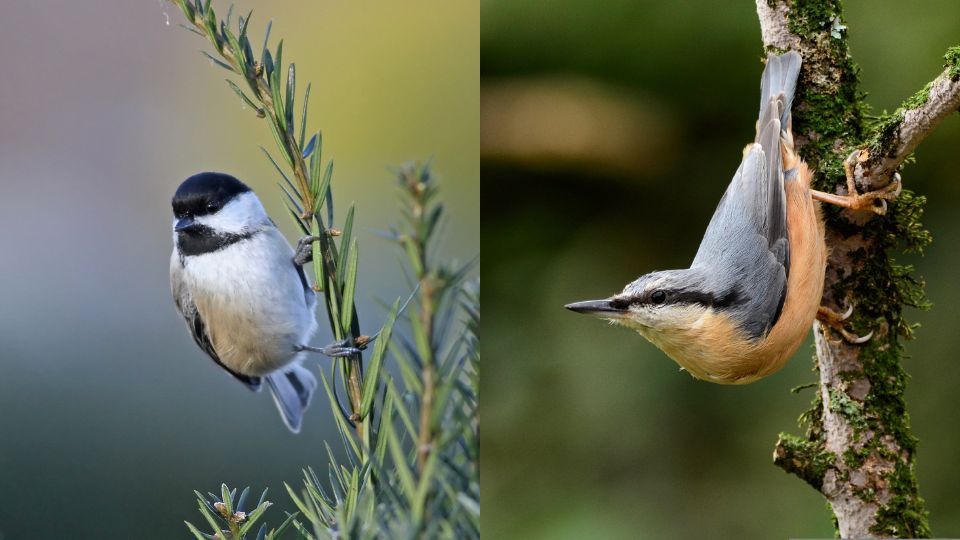Chickadees have a notable black cap on their head, stay in Northern American territories, excavate their own nests, eat mostly insects, and has a dee-dee-dee song. A nuthatch is bigger, travels farther south, is a secondary cavity nester, eats all birdseed mixes, and sings wha-wha-wha song.
Spotting the difference between Chickadees and Nuthatches is challenging for a few reasons. First, they have very similar physical features and reside in similar habitats. These two songbirds are good friends in the cold winter and often travel together in flocks!
However, it’s simple to spot the difference between a Chickadee and a Nuthatch by taking note of a few distinguishing physical features, changes in habitats, songs, and behaviors.
Distinguishing Features and Appearance
While the Chickadee and Nuthatches share a lot in common, noting small differences in the patterns of their feathers makes it easy to tell the difference at a glance.
Chickadee
The Black Capped Chickadee is easily recognized by its black cap, which is unique only to the Chickadee. Other species of Chickadee, such as the Carolina Chickadee or the Mountain Chickadee, both possess their classic black cap and black bib. When in doubt, check for a hat!
The Chickadee also has white eyebrows and a downy white underbelly. They are small, measuring around 5 inches long, with an average wingspan of 7 inches. They are tiny and weigh between .3 and .5 ounces!
Nuthatch
The Nuthatch has a gray back, a black mohawk on top of its head, and a white underbelly. Its coloring is similar to the Tuft Titmouse, albeit a bit larger. While there are different species of the Nuthatch, such as the Red-Breasted Nuthatch and White-Breasted Nuthatch, the distinguishing characteristics remain the same.
Nuthatches are slightly bigger than Chickadees. They weigh between 1.3 and 1.7 ounces and are 4 inches long with a wingspan of up to 10 inches. However, the Pygmy Nuthatch is a little more challenging to distinguish between Chickadees. Just like Chickadee, the Pygmy Nuthatch has a similar black cap and underbelly. Luckily, the Pygmy Nuthatch is rare and often only spotted in the American Southwest (where Chickadees aren’t found).

Habitat Differences
Your location in North America won’t give many clues about these two songbirds’ differences. Nuthatches and Chickadees are year-round residents in much of North America, Canada, and Mexico. However, small differences in their overall habitats are worth noting.
The Chickadee loves colder climates and is a year-round resident in the Northern portion of the United States. Their habitat ranges from the northern tip of Canada and spans through the Great Lakes, New England, and parts of the Rocky Mountains.
If you live in the Southern portion of the United States, odds are it’s not a Chickadee at your backyard bird feeders. Chickadees are non-migratory birds and stick around during the cold winter months, often traveling together in flocks. To make things even more confusing, Chickadees sometimes travel in flocks with Nuthatches!
The Red-Breasted Nuthatch, Brown-Headed Nuthatch, and the White-Breasted Nuthatch have similar habitats. Nuthatches span almost the entirety of the United States, from California and New England down to Florida. They are also year-round residents in part of Canada down to Mexico.
Nesting Sites
The selected nesting sites of both chickadees and nuthatches are also very similar. They are cavity-dwelling birds and make their nests in rotted tree branches or old Woodpecker nests. While Chickadees love nesting in hollowed tree branches or cavities, their nesting habits differ slightly from Nuthatches.
Chickadees use their short (yet mighty) beak to excavate holes on their own, build nests with moss and soft grass, and position nests at least 5 feet off the ground. These small birds prefer to make nests in deciduous forests with plenty of nearby protection from predators.
Nuthatches are also cavity-dwelling birds, but they don’t excavate their nests. Instead, they often prefer old nests of other birds, such as the ones excavated from the downy woodpeckers, and opt for both coniferous and deciduous forests to make their homes. Nuthatches are secondary-cavity nesters, using old nests as their own.
Diet
The Chickadee and Nuthatch use their sharp beak to dig into tree bark in search of bugs. Their diets are so similar that they often travel together in flocks eating at the same bird-feeders during the cold winter months!
In the summer, when insects are plenty, the Chickadee diet consists primarily of bugs. They use their beaks to drill small bugs out of tree bark and prefer caterpillars over other bugs. Chickadees love caterpillars, they also eat spiders, snails, and even the eggs of other bugs.
When the weather turns cold, Chickadees turn to backyard feeders for nourishment and will eat sunflower seeds and suet. They will dive down to collect sunflower seeds to store in the bark of a nearby tree. For extra nutrition, they will also happily munch on suet feeders in the winter.
Nuthatches have a very similar diet to the Chickadee. As fellow non-migratory birds, nuthatches primarily eat bugs in the summer and forage for seeds and nuts in the wintertime. In the summer, they dine on insects such as caterpillars, beetles, ants, and even spiders.
When the weather turns cold, they travel with fellow Nuthatches and even Chickadees, Warblers, Wrens, Kinglets, and Grosbeaks in search of food. While they love sunflower seeds, fill your feeders with peanuts and other high-protein foods to keep their energy levels high.
Bird Calls and Songs
One great way to tell the difference between a Nuthatch and A Chickadee is by listening to their songs. While they look very similar, their songs are a clear giveaway! Even novice birders can quickly identify the classic dee-dee-dee call of the Chickadee. Often, you can hear the Chickadee call before you spot it fluttering from branch to branch in the trees. Dee-dee-dee is slow and short when mating and picks up in speed and frequency when they spot danger.
The nuthatch call is a unique wha-wha-wha pattern that sounds like it’s laughing. Compared to the chickadee, the call of a nuthatch is much lower in pitch and is only heard during mating season. Their contact calls, or sounds they make to communicate with each other, have a sharp yank sound, which can be heard yearly. They make this bleating call when foraging for food or spot predators.

Do Chickadees and Nuthatches Get Along?
Absolutely! One may even consider chickadee and nuthatches friends. While they don’t spend much time together during breeding, things shift during winter. Many backyard bird enthusiasts often spot flocks of Chickadees and Nuthatches traveling together as they forage for food.
They even communicate with each other by making quick chirps when they find a good food source or warning of nearby predators. Their friendship is delightful, but their shared physical features and personality traits make it a little challenging to spot the difference between these two friendly North American birds!

